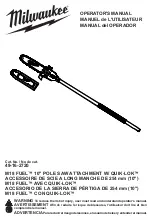
Page 6
For technical questions, please call 1-888-866-5797.
Item 63634
S
AFET
y
Op
ERA
TION
M
AINTENAN
c
E
S
ETU
p
19. Blades must be rated to at least the
maximum speed marked on the tool.
20. Maintain labels and nameplates on the tool.
These carry important safety information.
If unreadable or missing, contact
Harbor Freight Tools for a replacement.
21. Avoid unintentional starting.
Prepare to begin work before turning on the tool.
22. Do not lay the tool down until it has come to
a complete stop. Moving parts can grab the
surface and pull the tool out of your control.
23. When using a handheld power tool,
maintain a firm grip on the tool with both
hands to resist starting torque.
24. Do not depress the spindle lock when
starting or during operation.
25. Do not leave the tool unattended when the
Battery Pack is connected. Turn off the tool,
and remove the Battery Pack before leaving.
26.
The battery Charger gets hot during
use. The Charger’s heat can build up to
unsafe levels and create a fire hazard if
it does not receive adequate ventilation,
due to an electrical fault, or if it is used in a
hot environment.
Do not place the Charger on a flammable surface.
Do not obstruct any vents on the Charger.
Especially avoid placing the charger on carpets
and rugs; they are not only flammable, but they
also obstruct vents under the charger.
Place the Charger on a stable, solid, nonflammable
surface (such as a stable metal workbench or
concrete floor) at least 1 foot away from all
flammable objects, such as drapes or walls. Keep
a fire extinguisher and a smoke detector in the
area. Frequently monitor the Charger and
Battery Pack while charging.
27. This product is not a toy.
Keep it out of reach of children.
28. People with pacemakers should consult their
physician(s) before use. Electromagnetic fields in
close proximity to heart pacemaker could cause
pacemaker interference or pacemaker failure.
29. WARNING: Some dust created by power sanding,
sawing, grinding, drilling, and other construction
activities, contains chemicals known to the State
of California to cause cancer and birth defects or
other reproductive harm. Some examples of these
chemicals are:
• Lead from lead-based paints
• Crystalline silica from bricks and cement or other
masonry products
• Arsenic and chromium from chemically treated
lumber
Your risk from these exposures varies, depending
on how often you do this type of work. To
reduce your exposure to these chemicals:
work in a well ventilated area, and work with
approved safety equipment, such as those
dust masks that are specially designed to filter
out microscopic particles. (California Health
& Safety Code § 25249.5,
et seq.
)
30. WARNING: The cord of this product’s
charger contains lead and/or di (2-ethylhexyl)
phthalate (DEHP), chemicals known to the
State of California to cause cancer, and birth
defects or other reproductive harm. Wash
hands after handling. (California Health
& Safety Code § 25249.5,
et seq.
)
31. The warnings, precautions, and instructions
discussed in this instruction manual cannot cover
all possible conditions and situations that may
occur.
It must be understood by the operator that
common sense and caution are factors
which cannot be built into this product,
but must be supplied by the operator.
Lithium Battery Safety Warnings
LITHIUM BATTERIES STORE
A LARGE AMOUNT OF ENERGy AND
WILL VENT FIRE OR EXpLODE IF MISTREATED:
1.
Keep Battery pack dry.
2.
DO NOT DO ANy OF THE FOLLOWING
TO THE BATTERy pAcK:
a.
Open,
b.
Drop,
c.
Short-circuit,
d.
puncture,
e.
Incinerate, or
f.
Expose to temperatures greater than 140°F.
3. Charge Battery Pack only according
to its Charger’s instructions.
4. Inspect Battery Pack before every use;
do not use or charge if damaged.


































